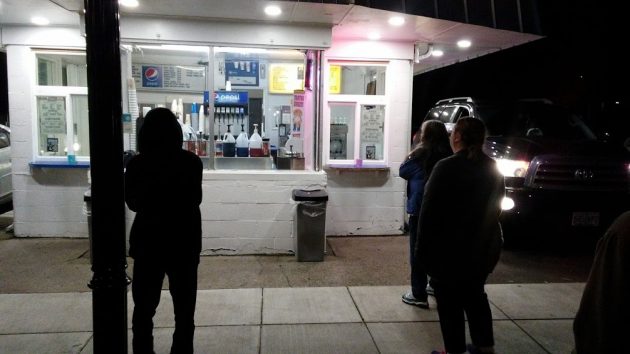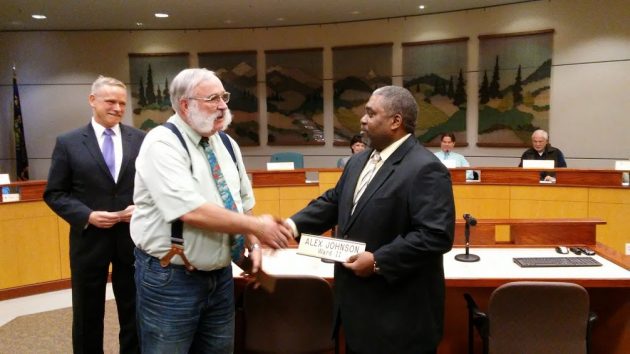
On Feb. 10, customers wait at Hasty Freez, the kind of place that makes a strong town.
What makes communities successful and strong, and what makes them less so year by year? There’s a new book out on that subject, and the Albany City Council now has copies thanks to former Councilman Ray Kopczynski.
The title is “Strong Towns, a Bottom-Up Revolution to Rebuild American Prosperity,” by Charles L. Marohn Jr. The author, an engineer and former city planner, has built an online community on the “Strong Towns” theme, which holds that American cities have developed the wrong way since the Second World War, and this is the reason most don’t have nearly enough money for what they want to do.
I’ve read some of the “Strong Towns” material. One theme is that cities have built a lot of things — like many miles of streets in new developments — without any thought of where the money comes from to maintain them in the decades to come. That’s the case in Albany, which constantly pleads it has no money to repair residential streets, and makes that point again in the City Bridges newsletter that just came out.
Another theme is that older, established neighborhoods are a better financial bet for cities than fancy new ones on the outskirts.
How to rebuild and improve those old neighborhoods? Chapter 8 of the book has one simple-sounding approach of four steps: 1. Identify where people in the neighborhood struggle going about their daily routine. 2. Identify the next smallest thing that can be done today to address that struggle. 3. Do that thing. Do it right away. 4. Repeat the process.
The author explains: “Identifying where people struggle requires a humble form of public engagement. Those making these investment decisions need to literally walk in the footsteps of the people they are serving, to be present as they experience the city. Consider it product testing: to observe how people are using that which has been built.”
What’s he talking about? Maybe a sidewalk where there isn’t one. Maybe a way to avoid a dirty alley when walking to school. How about a street light on a scary corner? Talk to the people on that street and see what they see.
No studies are needed. No consultants. No elaborate reports. And often, no great expense. Some rules may have to be broken, or at least temporarily ignored. But the lives of people living in the neighborhood are made just a bit better. Then, as the man says, do it again.
“Strong Towns” came to mind the other night as I was getting something to eat at Hasty Freez downtown. Albany avoided a big mistake and made the right decision when it sited the new downtown fire station so that this business could stay where it had been for many, many years. It’s not fancy, but it serves people in the neighborhood (along with many others), is locally owned, and makes great burgers and shakes. Without it, that part of town would not be the same. It would be poorer.
There is more to the “Strong Towns” thinking. Having followed Marohn and his associates via email for some time, I know that reading their stuff is time well spent. If council members crack open the books they got from Kopczynski on Wednesday night, they likely will thank their former colleague for the ideas the gift contains. (hh)

Ray Kopczynski (in shirtsleeves) as he was leaving the council in January 2019, with his successor, Alex Johnson II.


Gee. Is that the same Ray who referred me to some city study when I pointed out that the city didn’t have a chance in hell of rebuilding their streets and eventually they would all be gravel. All you have to look at is the government’s cost of doing anything and see what the future holds.
Yes Al, it is… Here’s my notes I used for my short address to council:
“I was given a copy of this book by Ron Green – a Carousel Volunteer I see regularly. It’s a “short” read – and I was gobsmacked by what I had read! So I ordered ample copies to share. (It’s the first time I’ve ever done this…)
Obviously, I’m most definitely not a “planner” nor an “engineer” by training as is the author.
However, I would like to believe that those of you who choose to read the book, would be willing to have some conversations about his conclusions – and – I hope someone might be able to show me the inherent & intrinsic errors of his thinking and why they would not work.
Because: If his “math” is remotely accurate and is valid with statistics & examples, it really upsets the apple cart as to “how” (and why) we’ve been planning our towns since WWII – and the repercussions we’re all now facing.
Interestingly, they will totally please (and totally offend) both conservative & liberal ends of the political spectrum.
He does offer ideas for solutions, all of which will take serious and incremental steps to achieve. None of it happens overnight, but staying the course, as we have been for generations now, is not working. Taking small steps aka what he suggests, might just be a better course of action…”
I’m not sure I understand the point you are making. In Albany resurfacing projects and reconstruction projects are done by private contractors.
So what would life look like using the “Strong Towns” approach?
More density, for sure. So the approach seems to be largely about imposing land use restrictions to force people to live on top of each other in an urban setting.
Then, spend tax money on a bunch of little things to make your crowded life more tolerable.
Do most people want to live this way? Will forcing more people to live on top of each other increase the tax base? Will denying single family homes in a suburb setting increase local government revenues? I doubt it.
Because it always comes down to government’s desire for more money. And this means controlling where and how you live. It’s called social engineering and most people resist being told what to do.
Our sense of community used to come from voluntary things that weren’t coerced: e.g. family, religious structure, and private fraternal organizations.
If you’re seeking salvation through government, then “Strong Towns” is your bible. Sorry, I’ll take a pass.
You & many others need to read the book! ( https://strongtowns.org/book )
As I mentioned in my comments to the dais, it *will* tick off both sides of the political spectrum… :-)
Plus one for Hasty Freeze!
Very interesting.
I apologize for over commenting on this issue, but your article about Albany giving a developer $500K captures one of the issues identified in “Strong Towns.”
https://hh-today.com/in-south-albany-a-plan-to-help-big-subdivision/
I recommended veering away from the city’s standard approach by implementing a special purpose taxing district. In other words, the user pays for the development’s infrastructure, not every city taxpayer.
But Ray K objected. Instead, he advocated the status quo. In other words, big development – lots of infrastructure – city subsidy – every taxpayer.
And now Ray is pushing this book?
Here is what the author said on p. 130, “There is no reason for any North American city to build another foot of roadway, or put in another length of pipe, to serve any new property anywhere.”
I’m not convinced by many of Marohn’s arguments, but this is one I agree with. And the local politician pushing Marohn’s book isn’t willing to dive into these waters.
What’s up with that?
I’ve had an epiphany after reading the book. Hence my ordering 15 copies to disseminate to council & staff…
Perhaps R.K. flogged the book ironically.
He’s a crafty devil, that one!
Nope — Just getting more education the older I get… :-)
How about a moratorium on new homes for three years? Concentrate on what needs to be done on the infrastructure and concentrate on making our community better not bigger.
Video of council meeting – and my 3 minutes of comment start/end: @18:20-21:20 here:
https://www.youtube.com/watch?v=VeIZWhcLYQI
Well
RayK received a book that he finds enlightening.
Based on this column, the book seems to promote a system of urban management that’s much different from the Robert Moses method.
Given the carping about current conditions, mayhap this is worth consideration.
At least a few conversations! And a pox be on the person to whom you refer… :-)
Moses or Marohn, it’s still top-down government mandated land use.
Better to read Jane Jacobs. At least she recognized the importance of decentralized, market-driven planning decisions.